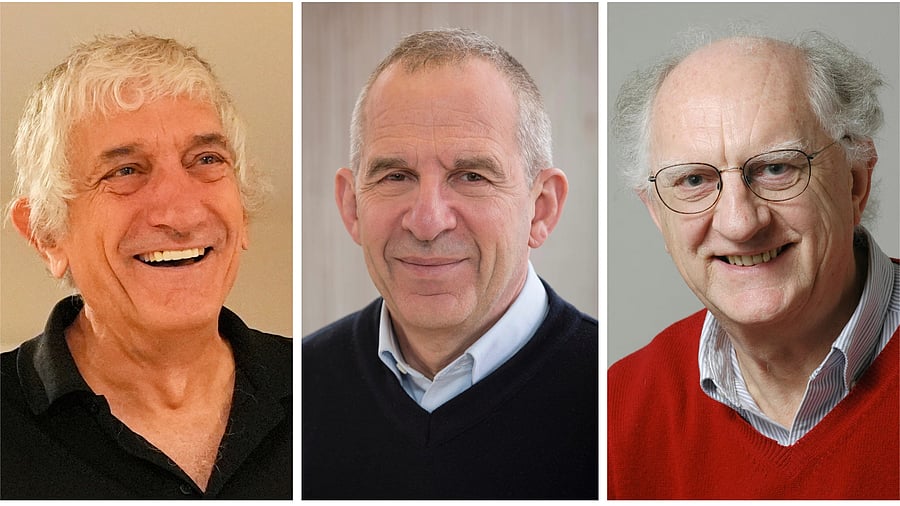
The 2025 Nobel Prize in Physics was shared between three scientists: John Martinis, Michel H Devoret and John Clarke.
A century-old branch of physics, quantum mechanics, explains phenomena that remain mysterious under classical mechanics. Among its counterintuitive predictions is tunnelling—a process that allows a particle to pass straight through an energy barrier that it classically should not cross.
This year’s Nobel Prize in Physics has been awarded to three American physicists—John Clarke of the University of California, Berkeley, Michel H. Devoret of Yale University and the University of California, Santa Barbara, and John M. Martinis of the University of California, Santa Barbara—for their pioneering experiments in the mid-1980s that revealed macroscopic quantum tunnelling and quantised energy levels in a system large enough to be visible to the naked eye.
When these experiments were conducted in 1984 and 1985, Martinis was a PhD student, Devoret a postdoctoral fellow, and Clarke their supervisor. Their research demonstrated that even a macroscopic electrical circuit could display quantum behaviour when carefully shielded from environmental noise. Two of the three laureates also went on to play key roles in industry: Devoret now serves as Chief Scientist at Google Quantum AI, and Martinis led Google’s Quantum AI Lab until 2020.
Quantum mechanics forms the foundation of modern technology and continues to demonstrate its relevance in new domains. Transistors in microchips, lasers, cameras, cell phones, and fibre-optic networks—all integral to everyday life—are direct outcomes of quantum principles discovered during the twentieth century. Today, these principles are driving the next wave of innovation in quantum technology, including quantum computing, cryptography, and sensing.
Particles the size of atoms, electrons, protons, or neutrons behave very differently from the objects we observe daily. Their actions are governed not by Newtonian laws but by the probabilistic rules of quantum mechanics. They can tunnel through barriers, exist in multiple states simultaneously, and occupy discrete energy levels rather than a continuous spectrum. A familiar analogy helps: when a ball is thrown against a wall, it bounces back; but a quantum particle, under the right conditions, has a finite probability of appearing on the other side of the wall without ever “breaking through” it.
Drawing from existing research
In 1973, Brian Josephson received the Nobel Prize in Physics for discovering that an electric current could flow between two superconductors separated by an insulating layer—a setup now known as a Josephson junction. This device became a cornerstone of precision measurement and quantum electronics, enabling scientists to explore the delicate boundary between classical and quantum phenomena.
Building on Josephson’s work, Clarke, Devoret, and Martinis used a similar configuration in their 1984–85 experiments. Their superconducting circuit consisted of two superconductors separated by an insulator and connected to a voltmeter that initially read zero. Under normal conditions, no current should cross the insulator, yet in a superconductor—where electrons move collectively as one coherent quantum wave—current can flow without resistance. The researchers meticulously isolated the setup to prevent interference from external noise that could destroy the fragile quantum effects.
Their measurements showed that the electrons in the circuit occupied quantised energy states. Each transition between states involved the absorption or release of a fixed quantum of energy, which was reflected in the voltmeter readings. The absence of intermediate values confirmed that the system’s energy levels were discrete rather than continuous—a hallmark of quantum mechanics.
The experiment also revealed macroscopic quantum tunnelling: the collective quantum state of billions of electrons passed through the insulating barrier, a feat analogous to a single particle tunnelling through a wall. The observation proved that quantum effects could manifest in systems far larger than individual atoms or particles, provided they were sufficiently isolated and cooled.
The question of how large a system can still exhibit quantum behaviour remains open. The 1984–85 experiments by Clarke, Devoret, and Martinis provided the clearest demonstration yet that macroscopic objects, under precise conditions, can display quantum mechanical properties. This insight laid the groundwork for creating quantum bits (qubits)—the basic units of information in quantum computers, which exploit superposition and entanglement to perform operations that classical computers cannot efficiently handle.
Quantum computing, once confined to theoretical physics and laboratory prototypes, is now entering real-world testing and industrial research. Sectors ranging from energy, logistics, and materials science to artificial intelligence and cybersecurity are exploring how quantum algorithms might solve problems that classical computing cannot. Potential applications include secure quantum communication, ultra-sensitive sensors, new materials and drugs, climate modelling, financial forecasting, and even carbon capture technologies.
The discovery honoured by this year’s Nobel Prize bridges a profound scientific divide—showing that the bizarre behaviour of subatomic particles can, under the right conditions, scale up to the macroscopic world we inhabit. It is a reminder that the principles of quantum mechanics, once thought to apply only to the invisible realm of atoms, continue to expand the boundaries of what technology—and imagination—can achieve.
(The writer is a former bureaucrat and a science communicator)